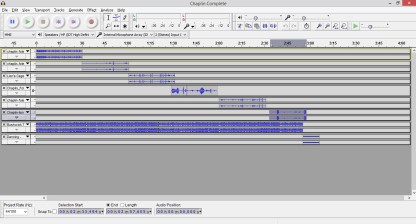For this assignment I took a look at a clip from an oldie but goodie, Bruce Almighty. I am huge Steve Carell fan, so this was the perfect clip for me to analyze.
I took a look at this clip from three different vantages to fully appreciate the various elements of the film.
1. Camera Work
The first element I looked at was the visual. I noticed that the clip starts out from the inside of a room that the main character, Bruce, was looking into. The camera then cuts to see the same room from Bruce’s view on the other side of the glass. This idea of parallel views is then revisited in the next part of the scene which starts out with Bruce watching Evan the anchorman on the TVs in the production room, to then watching him live in the studio. The scene seems to focus on individual characters at a time jump cutting to the funny facial expressions of Bruce, Evan, and the news producer.
The director then uses the “from below” angle I mentioned learning about in a previous post, to show the character of Bruce doing something devious, although it’s hard to tell what he’s up to without the context of the sound. The camera angles then move back to the individuals jump cutting to multiple characters clearly indicating that something is not usual about this news broadcast. When the camera moves to show the news teleprompter, we can then realize that the text is not usual of a news broadcast and that Evan the anchor is reading some pretty silly and incriminating stuff to the world. The camera moves back and forth from the anchor to the production crew indicating showing the anchor trying to remain calm and the crew frantically trying to figure out what is going wrong.
The camera then goes back and forth between Bruce and Evan demonstrating that what Bruce is doing is manipulating Evan somehow as Evan, seemingly uncontrollably, replicates Bruce’s actions. The clip concludes with this understanding as Evan’s co-anchor looks on with confusion and then cuts to Bruce laughing in the back.
2. Audio Track
The next thing I looked at was the audio track. The clip opens with standard news intro music and the announcer introducing the news casters. We then hear the news music soften as the co-anchors introduce themselves and Evan uses his catch phrase “Here’s what’s making news.” He begins a normal news story when he suddenly makes a strange sound, then clears his throat. He can’t seem to lose the strange voice and noise as his co-anchor offers him a glass of water.
Evan recovers and his voice is back to normal, although the text he’s reciting is not a normal news story. The scene then cuts to the production team confused about what was being said. The production team is instructed to check the prompter and we hear some light sound affects as buttons are click and equipment is moved. As Evan continues to read strange stories, we hear overlayed a chuckle from someone else. We then hear the rustling of paper as Evan apologies for the technical difficulties, but we are soon met then with the sounds of flatulence as Evan continues to apologize. The remainder of the clip is Evan speaking loudly but incoherently and ends with a small snippet of the news music used in the intro.
3. The Whole Shabang
This clip is a great example of how video and audio work together. Without the audio, it’s not clear what exactly is wrong with the broadcast as we can’t hear the bizarre sounds or text from Evan. Without the video, we may not gather that Evan’s character is being manipulated by Bruce, because we can’t hear Bruce or know what he’s doing in the scene. The panic in the voices of the production crew combine with the jump cut editing, creates a sense of nervousness as the audience waits to see how everyone will respond.
Another thing I think the audio and video combined help emphasize was the comedic element of the scene. The main actors in this scene are both very expressive and outlandish, but without the audio, there is a lack of story to their expressiveness. On the other hand, without the video we lose most of what the clip is about in that we can’t see that Evan is being manipulated.
It’s clear that these elements must work together to create the story for this clip, but in thinking back to the audio stories of the age of radio such as Little Orphan Annie, or the silent films of the 1920s, both methods worked very effectively without the other element. Perhaps it’s not that both are necessary, but rather both are tools in storytelling. Building the story is principle, which tools are used in support of the story are left to the designer/director to decide.





